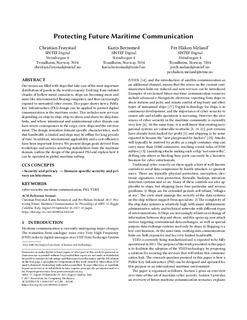Protecting Future Maritime Communication
Chapter
Published version
Permanent lenke
http://hdl.handle.net/11250/2458599Utgivelsesdato
2017Metadata
Vis full innførselSamlinger
- Publikasjoner fra CRIStin - SINTEF AS [5801]
- SINTEF Digital [2501]
Originalversjon
Proceedings of The 12th International Conference on Availability, Reliability and Security (ARES 2017), 10 pagesSammendrag
Our oceans are filled with ships that take care of the most important distribution of goods in the world economy. Evolving from isolated chunks of hollow metal containers, ships are becoming more and more like interconnected floating computers, and thus increasingly exposed to unwanted cyber events. This paper shows how a Public Key Infrastructure (PKI) design can be applied to protect digital communication in the maritime sector. This includes new services depending on ship-to-ship, ship-to-shore and shore-to-ship datalinks, and where intentional and unintentional cyber threats can have severe consequences to the cargo, crew, ships and the environment. The design considers domain specific characteristics, such that bandwidth is limited and ships may be offline for long periods of time. In addition, international applicability and a cost-efficiency have been important drivers. We present design goals derived from workshops and surveys involving stakeholders from the maritime domain, outline the design of the proposed PKI and explain how it can be operated in global maritime setting.

